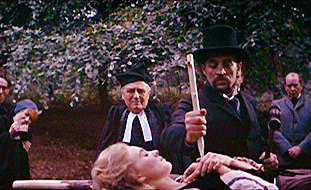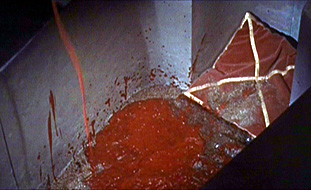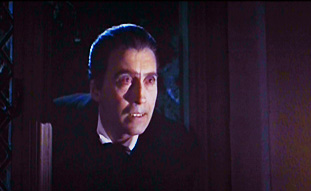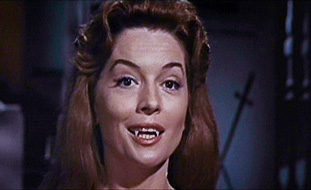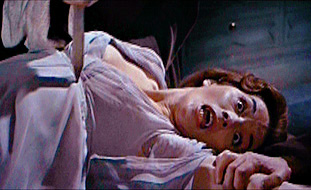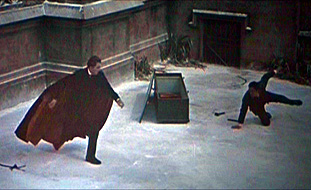|
Two English couples on a sightseeing tour in
Eastern Europe find themselves abandoned by their coachman. Much to their
surprise, a carriage with horses, but no driver, pulls up and carries them
to a nearby castle. Inside, they find a dinner table set for four, and
their luggage already deposited in the bedrooms. What are they to make of
this strange hospitality? At length, a rather gloomy servant explains: the
late Master left instructions for the Castle always to be kept ready to
receive guests. The travelers drink a toast to the memory of the departed
lord: Count Dracula, of an old and distinguished family... Virtues and Vices
This film was the third in Hammer's Dracula series, but only the
second direct sequel, since Dracula himself was absent from the
misleadingly-titled Brides of Dracula. Though the film gains a lot
from Christopher Lee's magnetic presence, he says that he found the dialog
written for the character so bad as to be "unsayable." As a
result, in the film as shot, the Count's utterances are limited to a
cat-lack hiss of anger and a howl of dispair at the end. Surprisingly, Lee
still gets a lot of mileage out of the role through clever use of body
language. He makes particularly eloquent use of his hands, such as when
Dracula is first awakened and his fingers crawl up over the edge of the
sarcophagus; and later, when his imperious gesture compells the heroine to
put her crucifix aside.
Dracula faces a different foe this time in the
person of Father Sandor, a gruff and eccentric clergyman who totes a
rifle. Andrew Keir embodies him as a larger-than-life figure: bearlike but
steadfast, outwardly a man of action while inwardly a main of faith.
The hapless travelers are a more mixed bag. As
the party-happy Charles, Francis Matthews sounds uncannily like Cary Grant
in some 40's comedy. Barbara Shelley, though revered among horror fans,
plays here a crabby, uptight woman who's all the more irritating for being
the only one in the group with a trace of common sense! It's a decided
relief when she comes to a bad end.
Literary Echoes
Having returned to the Dracula character, Hammer's scenarists John
Elder and John Sanson seem to have decided to pick up on some elements of
the original novel that never made it into Horror of Dracula. Thus,
there is a Renfield-like character named Ludwig , who is mentally
unbalanced, kept in a locked cell and prone to eating flies. He also
fill's Renfield's original function of inviting Dracula into the building.
Another key scene from the novel is echoed when Dracula cuts open his own
chest to feed his blood to the heroine, Diana. The paternalistic way the
men attempt to exclude Diana from their hunt of Dracula also echoes the
treatment of Mina by the men in the novel. Finally, the comic figure of
Father Sandor reminds us of the buffoonish side of the novel's Van
Helsing. This is an aspect of Van Helsing that was omitted from the
character in the Hammer films.
Geography
In this story, Dracula's castle is said to be near Carlsbad. The only
Carlsbad that I have been able to locate on European maps is a spa town at
the western end of the Czech Republic, and is currently better known as
Karlovy Vary. However, this is probably not the Carlsbad from the movie,
which is supposed to be located in the Carpathian mountains. In modern
terms that would place it somewhere in Romania, the Ukraine or Slovakia.
For consistency with the preceding film, you would have to assume that
Carlsbad is in Romania near Klausenberg (Cluj-Napoca).
Dracula Revived
This movie first provided the rationale that Dracula can always be
revived by the simple addition of fresh human blood to his ashes. The
notion recurs in later Hammer sequels, but is never rendered more
gruesomely than here, where gallons of blood from a freshly slaughtered,
hanging victim are poured into the Count's ashes in the sarcophagus.
Vampire Lore
Father Sandor delivers the obligatory vampire lecture here. He begins
by confirming the primacy of Dracula: "And the
fountainhead of this obscene cult was Dracula himself. I thought we'd seen
the last of him."
He explains the strange state of the vampire:
"He is already dead. He is Undead, Mr.
Kent. He can be destroyed, but not killed." Of another vampire,
Sandor says: "Bear in mind, Mr. Kent: This woman is not your
sister-in-law. She's dead. This is the shell, and what it contains is pure
evil. When we destroy it, we destroy only the evil." This is all very
pre-Ann Rice, so there is no sign that these creatures have any redeeming
features. Dracula has so little regard even for his latest vampire femme
that he simply hurls her aside when she seeks his approval.
Of Dracula's powers, the remarkable strength is
demonstrated here when he breaks a sword with his hands. His hypnotic
force also comes into play when he bends Diana to his will. As in other
Hammer films, Dracula never transforms into a bat or other animal. The
issue of whether he casts a reflection is not addressed.
Sandor explains the rules for entering houses:
"What the inhabitants of these parts don't realize is that a
vampire cannot cross a threshold unless he's invited by someone already
inside. And if he is, all the garlic flowers in the world won't keep him
out."
Sandor's catalog of the methods for killing
Dracula is typical of the Hammer series: "He can be traced to
his resting place during the daylight hours and there, a stake through the
heart. He can be exposed to the direct rays of the sun. Running water will
drown him. The cross will burn him. He is not invulnerable." Although
Sandor prays after slaying the vampiress, there seems no need to pray
while slaying the creature, as would later be required in Dracula Has Risen From the
Grave.
The most striking scene from Brides of Dracula
is echoed here when Sandor uses the flame from a lamp to cauterize a
vampire bite that was received by the heroine. The implication is that she
would have been in danger if he had not done so, even though she had not
died or even lost significant blood at that point.
Dracula's Demise - Spoiler
In a nicely inventive climax, Dracula is trapped when Father Sandor
shoots holes in the ice around him, and finally falls through to a watery
demise. The sight of his face drifting beneath the ice is one of the more
authentically eerie images in the film.
Sugar and Spice
Sandor explains why Dracula is so difficult to kill: " You see, there are people who help him: apparently normal
human beings who aren't vampires themselves, but who—for reasons we don't
understand—are in his power. This Klove is such a man. Spending his
life at the castle. Waiting for such an opportunity as you presented him
with last night. A chance to resurrect his master."
Phillip Latham makes a memorably funereal
impression as Klove, who to all appearances meets his end when he is shot
by Charles. An oddity, however, is that in the later film Scars of
Dracula, the Count also has a servant named Klove (played in that film
by Patrick Troughton). In that film, Klove
is a much hairier and dirtier character, though even in Dracula Prince
of Darkness, it is remarked that Klove is none too clean. Are we to
suppose that Klove survived the gunshot wound? Perhaps he has unnatural
vitality due to some partial infection with the vampire taint. If these
Kloves are the same person, then he has certainly degenerated by the
latter film, when he can no longer make a polite impression, and has
become the target of regular sadistic cruelty from the Count. It doesn't
pay to serve the Dark One.
Dracula, Prince of Darkness: Click here for ordering information. |

